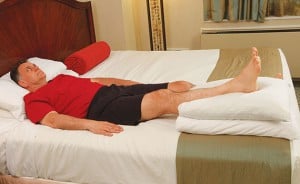Rehabilitation Guide
HSS Rehabilitation has prepared these video clips to help guide you through your recovery after your hip resurfacing surgery. If you have more specific questions, please contact your physician or physical therapist.
While performing all your activities, be sure to maintain any precautions given by your surgeon.
Exercises
Daily Activities
Step-through crutch walking on level surfaces with 2 crutches
Step-through crutch walking on level surfaces with 1 crutch
Going up stairs with 2 crutches using a rail
Going down stairs with 2 crutches using a rail
Going up stairs with 1 crutch using a rail
Going down stairs with 1 crutch using a rail
Going up stairs with 2 crutches when there’s no rail available
Going down stairs with 2 crutches when there’s no rail available
Preoperative Physical Therapy
Preoperative Physical Therapy for Left Hip Resurfacing Surgery
Hospital for Special Surgery Rehabilitation offers one-on-one preoperative physical therapy (PT) education sessions to individuals undergoing a hip or knee joint replacement surgery. During this preoperative education session you will spend one-on-one time with a physical therapist to learn and practice your surgeon specific post-surgical activities such as any applicable precautions, exercises, and activities of daily living. In addition to the preoperative PT education session, we recommend that you review this site several times in order to reinforce the information and optimize your preparedness for activity after surgery.
Contact Information
Pre-op Main 6
535 East 70th Street, 6th floor
New York, NY 10021
646.714.6844
HSS Paramus Rehabilitation and Performance
15 E. Midland Avenue, Suite 1A
Paramus, NJ 07652
201.599.8000
HSS Rehabilitation Westchester
1133 Westchester Avenue
White Plains, NY 10605
914.821.9100
Tips for Returning Home
Tips for Returning Home After Left Hip Resurfacing
Below are some general guidelines to assist you as you transition home after surgery. If you have specific questions, please speak to your therapist or call your physician’s office.
Driving
- Please check with your MD regarding instructions on driving.
Hygiene
- You may shower once you are home
Management of swelling
- You may encounter bruising and/or swelling in the operated leg.
- Swelling can be minimized by elevating the right leg when resting in bed.
- Icing may be helpful in managing swelling. Please follow your surgeon's instructions regarding ice application.
- When elevating the leg, the ankle should be above the level of the heart and the knee must be straight:

Around the house
- Roll up throw rugs and clear any loose wires from phones, computers, TVs, etc from the floor to reduce the risk of tripping and falling.
- Chairs that have arm rests are best to use. Avoid chairs with wheels that may move while you’re trying to sit down or stand up.
- Put nightlights near the bathroom and in hallways to help you walk around safely at night.
- If you have a pet who tends to jump up on you when you come home, it’s a good idea to keep them crated or in a separate room until you can sit down so that they don’t accidentally knock you off balance or get tangled under your feet.
What to eat
- Plan meals ahead of time that are pre-made, heat and serve, or easy to prepare.
What to wear
- Choose loose fitting clothing that is easy to get on and off.
- Wear a pair of slip-on rubber soled shoes for safer ambulation.
Exercise
- Try to walk short distance multiple times a day, increasing the distance/frequency as tolerated.
- Avoid cobblestones/slopes.
- At 2 weeks after surgery, you should be able to walk up to a mile cumulatively in a day.
- You many begin using a stationary bike as soon as tolerated.
- Please check with your MD regarding using the pool after surgery.
Follow-up appointment
- Your first MD follow-up is 4-6 weeks after surgery. Please call your surgeon’s office to make this appointment.
Post-Surgical Equipment
Below is a list of equipment that patients commonly use after surgery during the recovery phase. The list is not all-inclusive, and you may or may not need them all. If you have specific questions, please speak to your therapist.
- Crutches
- Long-handled reacher
- Long-handled shoe horn
- Sock aid
- Elastic shoe laces
- Slip-on shoes
- Raised toilet seat
- Long-handled sponge
Physical Therapy After Surgery
Your doctor will most likely recommend continued physical therapy (PT) after your discharge from the hospital. There are a few ways to go about that:
Home(care) PT
A physical therapist comes to your home a few times each week to provide your therapy, commonly through a certified home care agency.
In this option, the Case Manager who meets with you after surgery will make your home care arrangements through the agency serving your neighborhood. For more information prior to surgery call 212-606-1271. For issues regarding home PT after you’re discharged, call 212-606-1666.
Outpatient PT
Once you’ve gone home, you will travel a few times a week to a therapy facility for all of your rehabilitation appointments. You will need a prescription from your surgeon to receive outpatient PT.
If you don't already have a therapist in mind, you have the option of making your appointments at an HSS outpatient location. You can also contact the HSS Rehabilitation Network, a resource of qualified outpatient therapy facilities recommended by HSS. For more information about the HSS Rehabilitation Network, please call 212.606.1317.
